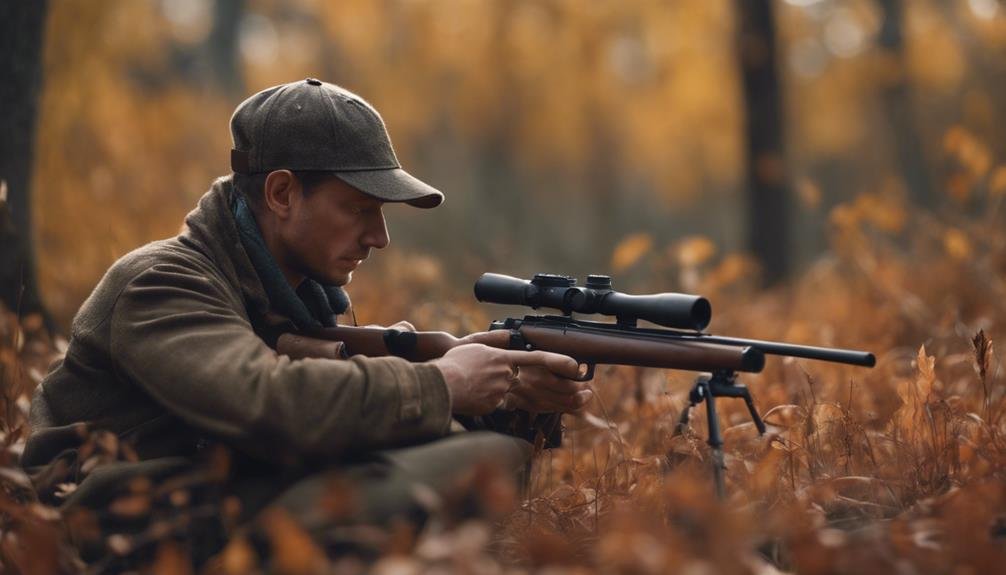To increase your chances of success in cottontail rabbit hunting, focus on mastering rabbit behavior patterns, optimizing hunting conditions, and developing effective hunting strategies. Understand that rabbits exhibit specific habits and traits that can be leveraged to outsmart them, and that communication plays a pivotal role in their behavior. By capitalizing on these cues, positioning yourself accordingly, and adapting to their habits and habitats, you can increase your success rate. By grasping these fundamental principles, you'll be well on your way to outwitting these elusive creatures – and uncovering the secrets to a successful hunt.
Key Takeaways
- Recognize and respond to rabbit communication cues, such as vocalizations and body language, to outsmart them.
- Hunt during optimal weather conditions, like warm winter days and seasonally mild temperatures, when cottontails are most active.
- Identify areas with limited escape routes, such as brush piles or overgrown homesteads, to increase the likelihood of success.
- Develop a 'milk run' of huntable spots to shorten the learning curve on subsequent trips and adapt to rabbit habits and habitats.
- Anticipate rabbit movements by understanding their behavior patterns, such as fleeing to dense cover when threatened, to position yourself accordingly.
Mastering Rabbit Behavior Patterns
Understanding cottontail rabbit behavior patterns is essential for a successful hunt, as these creatures exhibit specific habits and traits that can be leveraged to outsmart them. Rabbit communication plays a pivotal role in their behavior, with vocalizations and body language conveying essential information. Hunters can capitalize on this by recognizing and responding to these cues. In addition, understanding rabbit hunting instincts is key to anticipating their movements and behaviors. For instance, cottontails have a strong instinct to flee to dense cover when threatened, making it essential to position oneself accordingly. By mastering rabbit behavior patterns, hunters can develop effective strategies to outmaneuver their prey, increasing the likelihood of a successful hunt.
Optimizing Hunting Conditions
When it comes to optimizing hunting conditions, cottontail rabbits are most active during specific weather patterns and habitat characteristics, making it essential to identify and adapt to these factors for a successful hunt. Weather forecasting plays a pivotal role, as cottontails are more active during warm winter days and seasonally mild temperatures. Temperature tracking is also essential, as colder weather means planning afternoon hunts when rabbits are naturally more active. Sunrise hunting can also be effective, as rabbits tend to be more active during this time. By understanding these factors, hunters can increase their chances of success. Additionally, focusing on habitats with ideal cover, such as brush piles or overgrown homesteads, and limited escape routes can further enhance the hunting experience.
Effective Hunting Strategies
By adapting to the cottontail's habits and habitats, hunters can develop a range of effective strategies to outsmart their quarry and increase their chances of success. Understanding rabbit behavior and habitats allows hunters to anticipate their movements and plan accordingly.
- Identify areas with limited escape routes, increasing the likelihood of success.
- Develop a 'milk run' of huntable spots to shorten the learning curve on subsequent trips.
- Take note of how rabbits respond to pressure and plan accordingly for future hunts, outsmarting them with the right strategy.
Frequently Asked Questions
What's the Best Time of Day to Hunt Cottontails in Winter?
During winter, cottontails exhibit distinct dawn and dusk activity patterns. Prime hunting times occur just after dawn, when Winter Patterns dictate rabbits venture out to feed, making Dawn Risers prime targets, and again in late afternoon when they seek shelter.
Can I Hunt Rabbits in Areas With Heavy Human Activity?
While it's possible to hunt rabbits in areas with heavy human activity, cottontails often avoid urban habitats with high human disturbance, making it challenging to find them in these areas, and alternative habitats with less human activity may be more productive.
How Do I Handle Hunting Rabbits in Dense, Thick Cover?
When hunting rabbits in dense, thick cover, employ effective cover navigation techniques, such as slow and deliberate movements, to increase visibility and reduce disturbance. Utilize brush strategies like push-pull tactics and circle-waiting to outmaneuver and flush rabbits from dense habitats.
What's the Ideal Group Size for a Rabbit Hunting Party?
When it comes to rabbit hunting, a party size of 2-4 is ideal, allowing for effective communication and strategic deployment while respecting rabbit behavior and adapting hunting strategies to optimize success.
Can I Use Calls or Scents to Attract Cottontails During a Hunt?
When hunting cottontails, using rabbit whistles or scent types can be effective attractants. Soft, high-pitched whistles mimic a cottontail's distress call, while scents like apple or clover can entice them. However, be cautious not to overuse these tactics, as cottontails can become wary of repetitive stimuli.
Conclusion
In summary, a nuanced understanding of cottontail rabbit behavior, weather patterns, and habitat characteristics is essential for a successful hunt. By recognizing the intricate relationships between these factors, hunters can develop informed strategies to increase their chances of success. By mastering rabbit behavior patterns, optimizing hunting conditions, and employing effective hunting strategies, hunters can refine their skills and ultimately reap the rewards of their efforts, culminating in a bountiful harvest.








